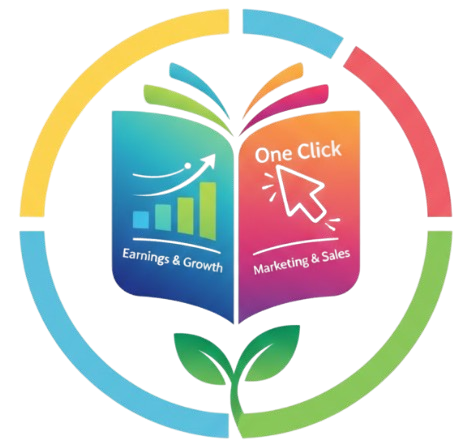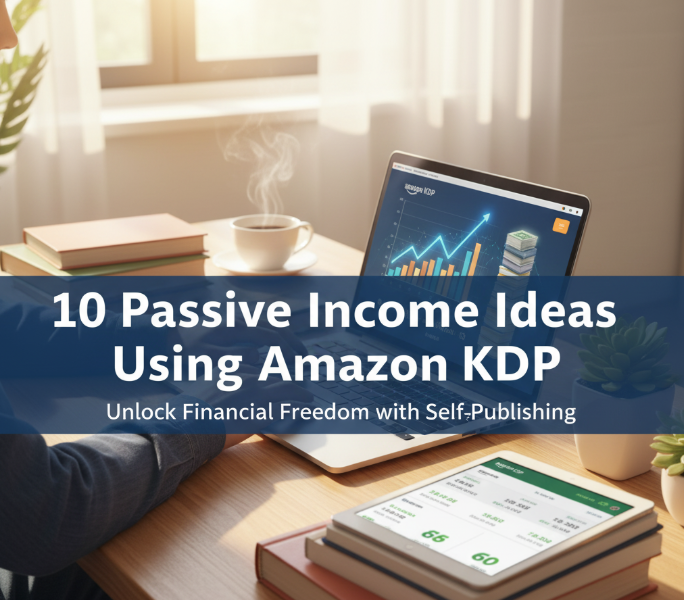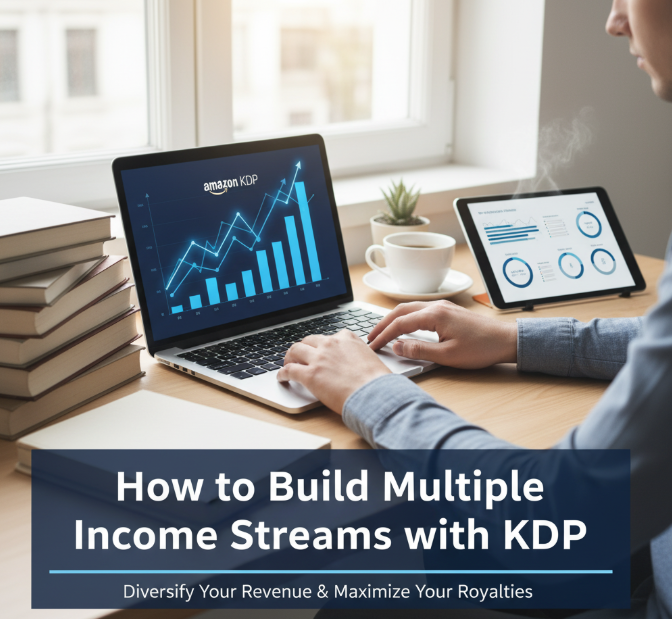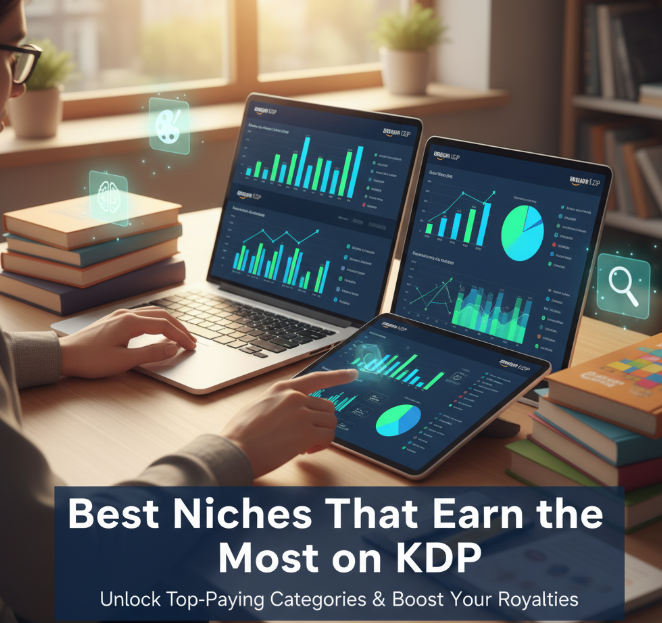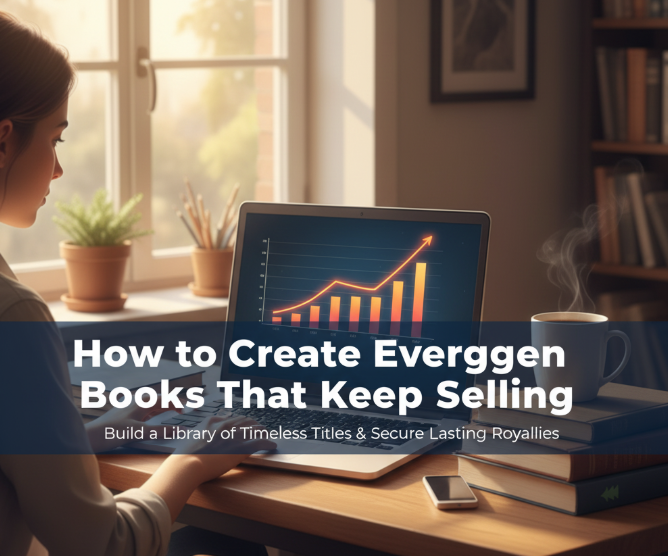Imagine this: You wake up, look at your phone and see that money was deposited into your bank account while you were sleeping. Sounds like a dream, right? With Amazon KDP, this fantasy comes true for thousands of authors every day.
Amazon KDP is a free publishing resource that enables all types of authors to publish and distribute their books directly to readers around the globe. The best part? For some methods, you don’t even need traditional publishers, fancy equipment or writing skills. And once your book is live, it can make money for months or even years with minimal work.
I’ll just guide you with 10 passive income stream ideas using Amazon KDP in this complete guide. Hello budding author, Whether you’re just getting started or ready to expand into an empire these strategies will help you begin earning money from your books while you sleep.
Why Amazon KDP is the Way to Passive Income Gold
Before we get to those ideas in a bit, first let’s take an overview of why Amazon KDP is such a unique passive income platform.
Amazon leads the industry and has more than 300 million active customer accounts across the globe. When you sell on KDP that means your books are listed next to the bestsellers of big publishing houses. You have access to the same huge audience, however you get to keep 35-70% of the royalties instead of that pittance traditional publishers give out.
The platform takes care of all the technical stuff: printing, shipping, customer service and payment processing. You just create content, and you market. Plus, there’s zero upfront cost. You can begin your publishing business with only an internet connection and time.
1. Low-Content Books: The Simplest Place to Start
Low content books take little writing and are great for newbies. These are books in which customers write the content.
Popular Low-Content Book Types:
- Journals and lined notebooks
- Planners (daily, weekly, monthly, yearly)
- Adult and children’s coloring books
- Password logbooks
- Budget trackers and expense logs
- Fitness and meal planning journals
- Gratitude journals
- Travel journals with prompts
How to Create Low-Content Books:
You can make those with free tools like Canva, or inexpensive software like Book Bolt. The insides are typically straightforward patterns, lines or grids repeated throughout. Success is all about cover and keyword research!
A well-crafted planner aimed at a specific niche (such as “Teacher Planner 2026” or “Wedding Planning Journal”) can sell hundreds of copies each month. Because you make it once and sell it forever, the potential for passive income is massive.
Earning Potential: Single low content books can make $50-$500 per month. Publishers ranging from 20-50 books in their catalog generate $1,000-$3,000 or more per month.
2. Coloring Books for Niche Audiences
Coloring books really deserve a separate category, since they’ve become so popular outside of the realm of children’s books. You know what they say: If a Krampus coloring book can be popular, anything can!
Winning Coloring Book Niches:
- Mandalas and meditation patterns
- Animals (specific breeds like French bulldogs or Maine Coon cats)
- Fantasy themes (dragons, fairies, unicorns)
- Seasonal and holiday themes
- Occupation-specific (nurses, teachers, firefighters)
- Sweary adult coloring books for stress relief
- Educational coloring books (anatomy, geography)
You could also design coloring book pages yourself in an AI program, hire a freelancer on Fiverr or Upwork for that purpose, or buy some ready-made coloring pages with commercial licenses. Investment runs $50-$200 per book, but a single successful coloring book can recoup that investment in the first few weeks.
Success Tip: Specialize in Super Specific Niches. Instead of “Animal Coloring Book,” take a look at “Cute Baby Farm Animals Coloring Book for Kids Ages 2-4.” Specificity is what will get you ranked higher in Amazon searches.
3. Public Domain Books with Extra Benefits
Public domain books are those whose copyrights have expired, meaning they can be republished freely. But just copying and pasting won’t do — you’ve got to add value.
How to Make Public Domain Content Valuable:
- Build themed collections (The Classic Mystery Short Story)
- Add modern illustrations or images
- Provide study guides or discussion questions
- Write comprehensive introductions or commentary
- Improve formatting and readability
- Create annotated versions with explanations
- Gather and publish collections of related works
Public domain can include classics, historical texts, or poetry books—pretty much any old book for which the copyright has expired. Websites such as Project Gutenberg provide thousands of free public domain texts.
But the good news is, you don’t have to actually create any content here. You are repurposing existing content in new, valuable forms. One publisher put together a series of classic novels with beautiful covers and interior design, making more than $5,000 a month from books they didn’t write.
4. Activity Books for Children
In their search to keep kids entertained and educated, parents are forever looking for cool activities. Activity books are ideal for this need, and make a great year-round item.
Popular Activity Book Types:
- Maze books in order of difficulty
- Spot-the-difference puzzle books
- Word search books with themed words
- Sudoku for kids
- Connect-the-dots books
- Tracing books (letters, numbers, shapes)
- Cut and paste activity books
- Brain teaser and logic games books
These books pair basic illustrations with things to do. You can make them via templates, or hire budget freelancers. The trick is to make multiple books in a series — kids can read through one fast and parents will buy the next.
Marketing Advantage: Activity books are great gifts, especially for holidays and summer vacations. You also receive plenty of reviews from happy parents, which helps to improve your rankings.
5. Recipe Books and Cookbooks
We all have to eat, and we’re all hunting around for new recipes. Cookbooks, especially those that focus on certain diets or cooking styles, have consistently been strong sellers there.
Profitable Recipe Book Angles:
- Diet-specific (Keto, Vegan, Paleo, Gluten-Free)
- Appliance-focused (Air Fryer, Instant Pot, Slow Cooker)
- Time-focused (30-Minute Meals, 5-Ingredient Recipes)
- Meal planning and budget cooking (Meals Under $5, College Student Cookbook)
- Cultural and ethnic cuisines
- Holiday and seasonal recipe collections
- Desserts and baking specialties
There’s no requirement to be a gourmet cook in order to make recipe books. You can publish your own family recipes, testing and photographing each dish yourself, or you can pool resources with others: sharing writers, hiring a roster of recipe developers and food photographers, or even partnering with a small press to produce books on their docket. Others are able to aggregate public domain recipes and update them for current measure and method.
Pro Tip: Include mouth-watering photos. Cookbooks with good food photography outsell pure text cookbooks any day. Stock photos with commercial licenses are an option, or you can work with photographers at reasonable prices.

6. Puzzle Books for Adults and Seniors
The puzzle market isn’t only for children, not by a long shot. Puzzle books make a great gift for adults and especially seniors because they offer entertainment, mental stimulation and stress relief.
High-Demand Adult Puzzle Types:
- Crossword puzzle books
- Large-print word searches for seniors
- Cryptogram puzzle books
- Number puzzles (Sudoku, Kakuro, KenKen)
- Logic grid puzzles
- Trivia and quiz books
- Brain games and memory exercises
There’s a whole large print edition market that appears to be virtually untapped and seniors are the target demographic. A lot of older adults love physical books and hate screens and are ordering puzzles like crazy.
Special software or expert staff is needed to create puzzle books, however, templates and puzzle generators are easily available. They’re the type of book that once you write them, they’ll sell well with little promotion because Amazon’s algorithm does the promoting for you.
7. Self-Help and Personal Development Workbooks
We are always looking to work on ourselves, so this category is always in fashion. Whereas classic self-help books draw from expertise, workbooks are based on exercises and prompts.
Popular Workbook Themes:
- Goal-setting and productivity planners
- Self-reflection and journaling prompts
- Relationship and communication exercises
- Anxiety and stress management workbooks
- Habit tracking and building guides
- Confidence and self-esteem builders
- Workbooks for career development and job search
- Financial planning and budget workbooks
The fact is that workbooks themselves are interactive, presenting information while bringing in interactivity as well. You offer these readers frameworks, exercises and pockets of pages to write their thoughts and answers.
If you’re knowledgeable in other areas of personal development, you can also add these to your portfolio or hire ghostwriters who are knowledgeable on the subject. A well-placed workbook in a niche audience can earn $500 to $2,000 a month for years.
8. Notebook Series with Creative Designs
Plain works, you will sell that. Creative is better. The market loves diversity, the market loves personality, the market loves use case.
Creative Notebook Ideas:
- Themed covers (specific professions or hobbies)
- Funny and sarcastic designs
- Stylish professional designs appropriate for a job at an office
- Notebooks tailored to interests (Gardening Notes, Recipe Testing Log)
- Fandom-themed designs (without copyrighted material)
- Seasonal and holiday designs
- Pet-themed notebooks featuring specific breeds
- Spiritual and inspirational designs
It’s the volume, and variety, that are key here. Design multiple notebooks for various audiences and interests. It doesn’t take very long to put each notebook together (excluding cover design), but over time creates a varied income.
Scaling Tactic: Some of the most successful notebook publishers have 100+ designs. Say each notebook only sells 10 copies a month at $2 profit, that’s $2,000 a month just from notebooks.
9. Educational Workbooks and Study Guides
Teachers and parents are perpetual buyers of educational materials to assist them in their work.
Educational Book Opportunities:
- Math, reading, & writing practice workbooks (grade specific)
- Study aids and exam preparation guides (SAT, ACT, GED)
- Handwriting practice books
- Phonics and early reading workbooks
- Times tables and math facts practice
- Science experiment journals
- History and geography activity books
- Foreign language learning workbooks
Educational books need a bit more expertise or research, but they carry higher prices and produce loyal customers. Parents will buy more than one book from your catalog.
You can also work with teachers or academics to ensure what you’re publishing is accurate and effective. Some publishers hire trained teachers to produce the content, and pay royalties – a real passive income model where others do the work but you publish and market.
10. Specialized Logbooks and Trackers
People enjoy tracking things — fitness progress, reading lists, movie collections, travel destinations and many more. There are logbooks especially designed to fulfill these desires.
Profitable Logbook Types:
- Reading logs and book journals
- Fitness and workout tracking logs
- Blood pressure/health check diaries
- Medication tracking books
- Sleep tracking journals
- Car maintenance logs
- Garden planning and harvest logs
- Fishing and hunting journals
- Pet health and veterinary records
- Home maintenance logs
These logbooks integrate a basic format with specific fields tracking the specifics of each activity. They solve practical problems for hobbyists who want to keep organized logs of their hobbies or track health information.
The competitive edge is in knowing your niche audience to the core. As a gardener, you make better garden logs than someone guessing at what a gardener needs. Get to know your target market by checking out Facebook groups, forums and shopping reviews on Amazon with similar products.
KDP Ideas Income Potential Comparison
| KDP Idea | Startup Difficulty | Creation Time | Monthly Income Potential | Long-Term Sustainability |
|---|---|---|---|---|
| Low-Content Books | Easy | 1-3 hours | $50-$500 per book | Excellent |
| Coloring Books | Easy-Medium | 5-10 hours | $100-$800 per book | Excellent |
| Public Domain Books | Easy | 2-5 hours | $50-$300 per book | Good |
| Activity Books | Medium | 10-20 hours | $200-$1,000 per book | Excellent |
| Recipe Books | Medium-Hard | 20-40 hours | $300-$1,500 per book | Excellent |
| Puzzle Books | Medium-Hard | 15-30 hours | $200-$800 per book | Excellent |
| Workbooks | Medium-Hard | 30-60 hours | $500-$2,000 per book | Excellent |
| Notebook Series | Easy | 1-2 hours | $25-$100 per book | Very Good |
| Educational Books | Hard | 40-80 hours | $500-$2,500+ per book | Excellent |
| Specialized Logbooks | Easy-Medium | 5-15 hours | $100-$600 per book | Very Good |
Must Have Tools and Resources For KDP Success
You don’t need the best writing software to write your book. These are the tools that successful publishers use:
Design and Creation Tools:
- Canva (free and paid covers/interiors)
- Book Bolt (complete KDP research and book creation tool)
- Adobe InDesign (professional option)
- Microsoft Word or Google Docs (word processors that are easy to format)
- GIMP (free Photoshop alternative)
Research Tools:
- Amazon Best Sellers Rank analysis
- Keyword research tools (Publisher Rocket, KDP Spy)
- Google Trends for seasonal demand
- Facebook groups for niche insights
Outsourcing Platforms:
- Fiverr to find cheap designers or writers
- Upwork for quality freelancers
- 99designs for professional cover contests
- Creative Market for templates and graphics
Building Your KDP Publishing Strategy
Random generation of the book will give you random results. Best-selling KDP publishers use strategic methods:
Begin with Research: Take your time to discover profitable niches before you create anything. Seek categories that are high demand but low competition. Look up the Best Sellers Rank (BSR) of bestselling books—anything lower than 100,000 means sales are brisk.
Produce Quality Products: Even if your work is low content, covers and formatting should be professional. There are over a thousand other books out there trying to be your book. Quality makes you stand out.
Create a Catalog: It’s rare that one book generates great passive income. Just publish a small number (not necessarily less than 6) your first year. The larger your catalog, the more you earn. Books are inherently networked, with customers finding other titles in your catalog.
Amazon Algorithm Optimization: You should leverage all of the seven keywords in your titles, write a very good description and select the right category as well as price. Amazon’s algorithm rewards books with exceptional sales out of the gate and a high conversion rate.
Collect Reviews: There is no doubt that reviews can bring in sales. Leverage Amazon’s request reviews button, offer value that inspires organic reviews, and leverage review programs (that align with Amazon’s policies).
Marketing Your KDP Books for Maximum Passive Income
It’s only half the battle to write a book and have it published. Smart marketing helps you to scale your passive income:
Amazon Ads: Begin with low budgets ($5-$10 per day) in automatic campaigns. Amazon ads help your books stay visible on search results and the book pages of competing books. Highly optimized ads will get you a 2-5x return on ad spend.
Social Media: Start a Facebook page or Instagram account for your books. Participate in relevant niche groups – here you’ll have to provide value before promoting your books. Pinterest is great for visual type books such as coloring and journal type products.
Email Sign-Ups: Build a mini website or landing page where you can give away free content in exchange for emails. Email subscribers convert to repeat buyers, especially for series or more than one book.
Content Marketing: Blog or make YouTube videos on topics related to your books. This sends organic traffic and builds authority. A blogger who is experienced in organization will of course promote their planning journals.
Cross-Promotion: Mention your other books in the back matter of each book. Readers who like one book frequently go on to purchase more by the same author.
Common Mistakes to Avoid
You don’t make mistakes – you learn from others’ mistakes. Cutting the learning curve: You benefit from someone else’s trial and error.
Copyright Infringement: Never infringe on anyone else’s copyright by using their images/characters/text. This can be fan art, a celebrity photo or a brand logo. Amazon does take this seriously and can ban your account.
Bad Keyword Research: Writing without knowing what customers are actually searching for is like opening a business on a dark and secluded street. Utilize keyword tools to know the volume of searches and your competition.
Ignoring Book Descriptions: This is your sales page. Leverage formatting, bullets and punchy language to turn browsers into buyers.
Underpricing: A lot of first time self-publishers under-price believing that will move more units. Higher prices are generally fine if quality is good and without a big drop in sales volume.
Quitting Too Early: KDP is NOT a shortcut to riches. It takes a while for books to catch on. Some books fail to catch fire at first, but are deemed bestsellers months later as Amazon’s algorithm, relentlessly wise to the actual appetite of readers, discovers them.
Disregarding Feedback: Please read your reviews and customer questions. They tell you what you’re doing right and where to improve. Tweak subsequent books in response to this feedback.

Growing Your KDP Passive Income Business
After you’ve established a proven track record, the ability to scale up your income multiplies:
Employ Virtual Assistants: Delegate research, formatting or uploading so you can spend more time strategizing and growing. A VA for $5-$10 an hour can handle the day-to-day as you grow.
Create Book Series: Series make more money. Readers reach the end of book one and immediately purchase book two. Plan series from the beginning.
Expand to Print and Audiobooks: Some people like paper books. Amazon offers expanded distribution. Present your content in multiple formats to appeal to traditional and new customer preferences and maximize per-title revenue.
Create Several Pen Names: Various pen names for various genres or niches keep your brand clear. Your name as a romance novelist remains separate from your children’s activity book author name.
Reinvest Profits: After you start making a little bit just reinvest that money on hiring better designers, advertising or even buying quality tools. Reinvestment accelerates growth exponentially.
Real Success Stories and Income Disclaimer
Setting realistic expectations is important. Most KDP publishers don’t go on to become millionaires overnight, but many of them generate significant passive income:
One publisher began with low-content planners, produced 15 different designs spanning various niches. At the end of three months, they brought home $200 a month. Within a year of publishing 80 books, income from the books was $2,500 per month. Two years later, and with 150 books along with a finely tuned advertising operation, they take in $5,000 to $7,000 a month.
Another publisher brought nothing but adult coloring books. By generating distinctive high-quality designs and targeting niche interests (famous landmarks, vintage fashion, Celtic patterns), they developed a catalog of 40 coloring books that generated $3,000-$4,000 a month.
A retired schoolteacher developed educational workbooks that drew on several decades of classroom experience. Ten well-done workbooks create $2,000-$3,000 a month in recurring revenue with very little marketing, doing very well for teachers and homeschooling parents who discover them through Amazon searches.
These aren’t flashes in the pan — they are sustained efforts over months or years. However, since the passive aspect exists, when you put in the work now, it continues to pay off for years.
Frequently Asked Questions
What investment do I need to start with Amazon KDP?
You can even begin with no money at all. Joining Amazon KDP and publishing is absolutely free. But spending $50-$200 on professional cover designs, quality interior templates, or for outsourcing specific tasks, dramatically increases your odds of success. Many of the most successful publishers began with free tools and then reinvested early earnings.
How fast can you make money on KDP?
Books are usually ready to launch 24-72 hours after publication. However, meaningful income takes longer. Most publishers will see no sales for the first month and then work their way up to earning around $500-$1,000 per month after 3-6 months of regular publications. More books published = more income, quickly.
Must I be the one doing the writing?
No! Some of the most successful KDP authors never write a word. Low content books don’t involve any writing, public domain ones are already written and ghostwriters are available for the rest. Success is more about research, design, and marketing than being a good writer.
Can I really make money on autopilot or do I always have to work with it?
After they are published, books provide truly passive income with little to no ongoing work. But creating is very active work. The most success for publishers comes from a combination of new creations and maintenance of what’s already there — updating keywords, running ads and creating new editions. Think of it as fairly passive with a little bit of upkeep.
What are the best-selling KDP books on Amazon?
Books that solve a particular problem or meet an obvious need sell the best. This area also includes practical books (planners, trackers, educational workbooks); entertainment titles (puzzles, coloring) and niche content (specialized cookbooks, hobby logbooks). You don’t want completely broad topics, and you need to target exact audiences with search intent.
How many books do I have to publish to earn good money?
There is no magic number, but most successful publishers have anywhere from 20-100+ books available in their catalogs. Every once in a while, you will find that one amazing book can produce significant income on its own, but diversification helps combat market shifts and Amazon algorithm changes. Expect to publish often—at least one book per month in the beginning.
How do AI tools such as ChatGPT influence KDP earnings?
Content creation is changing, though AI tools have yet to obliterate potential. In fact, they’ve made some kinds of books much easier to make. But Amazon also has policies against AI-generated work being sold as human created without any disclosure. Use AI as a research tool or to help in organizing, but concentrate on building real value that readers want.
How do I handle bad reviews?
Every reader won’t enjoy every book, and that’s all right. Respond professionally to constructive criticism, do not get into arguments with reviewers and let feedback help you make future books better. Most buyers realize that a couple of negative reviews in the midst of many positive ones is to be expected. Concentrate on giving great service all the time to keep your general rating very high.
Your Next Steps: Get Involved Today
You can be inspired by reading about structures designed to generate passive income, but no flow of cash emerges from thin air; it has to be triggered. Here’s your step-by-step starting plan:
This Week: Pick one KDP idea from this article that excites you. Research the niche on Amazon — look at bestsellers, read reviews and look out for gaps in the market that you could fill.
This Month: Get that first book written and out there. It doesn’t even need to be perfect. Real-world feedback beats endless planning. Use free tools or invest in a single professional element, such as cover design, and knowing you have at least that one piece nailed down should provide some comfort.
Next Three Months: Publish 5-10 books, see what works, and shift your strategy. See which books people go for, and make more in those niches. Begin experimenting with Amazon ads on your best performers.
This Year: Create a base of 20-30 books in various niches. Create systems to be more efficient or outsource some of the work. Optimize your current books with performance data.
The magic of Amazon KDP is that each book you publish becomes an asset that can earn money for decades to come. Although some books won’t do well, you never know when one will exceed your wildest dreams. The key is beginning, continuing to learn and methodically building your publishing business.
Passive income isn’t without effort — it’s frontloaded work that keeps paying long after you’ve put in the time. Amazon’s huge marketplace, battle-tested tactics and reliable implementation can help you create a real passive income that will actually make money while you sleep.
The point isn’t is it possible to make passive income with Amazon KDP – thousands of publishers are doing that daily. The real question is this: When will you publish your first book and stand next to them?
